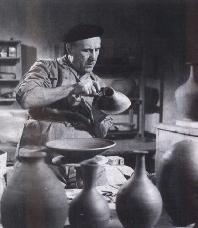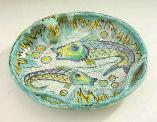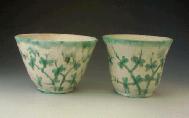|
Gorka Géza |
 
Géza Gorka'sworks
exhibitions of the 1930-40's:
|

|
 |
|
ceramics from 1935
|
ceramics from 1940
|
|
 |
 |
|
ceramics from 1942
|
from the first Hungarian Ceramic Exhibition's
Collection |
|
(Nagytapolcsány, September
6. 1894. - Veröce, September 25. 1971.)
Attended his
schools in his native town, Trencsén. In 1918, moved with his family to Mezőtúr
and upon the influence of Balázs Badár working there, he chose ceramics as his
vocation. In 1919-21 studied with Paul Mann and Max Laeugner in the Majolica
Manufacture in Lentkirchen. Germany, where he learnt the use of cracked glazes.
Moved to Nógrádverőce in 1923 an founded the Keramos Ltd., then in 1927 built
his workshop. In 1928-29 pursued studied under the tutorship of Géza Jakó. In
1940-44 headed the ceramic workshop in Losonc, and returned to Nógrádverőce in
1945. In 1946-48 carried outexperiments fot the mass production of high-fired
vessels in the Zsolnay workshop in Öv street, Budapest. In 1970, he undertook
the launching of the ceramic course in the Zebegény Free School. One of the
founders of modern Hungarian ceramic art, he was influenced by folk pottery,
German expressionism and art deco simplified in a modernist spirit. Ornamental
and functional ceramics features with equal weight in his work, and his entire
career was accompanied by the investigation of technical and technological
innovations. He was master of colours and glaze. From the '60s, his art lived to
see a second blooming on the basis of his style developed before the war.
He was member of the directorial board of the Association of Hungarian Designers
from 1930. The Gorka Ceramics Museum was opened in his former home and workshop
in 1972.

 - The marks of Géza Gorka
- The marks of Géza Gorka

|
 |
1. Gorka Géza - Ashtray with chameleon
between 1927-30, early work
Spots are on body of the chameleon |
 |
2. Gorka Géza - Ornamental plate, woman figure
between 1930-35
Marked on the bottom, scratched: Gorka, above mark of
Nógrádveröce workshop
high: 24,5cm
|
 |
3. Gorka Géza - Table plate
between 1930-35
Marked on the bottom, scratched: Gorka, above mark of
Nógrádveröce workshop
size: 8 x 28cm
|
 |
4. Gorka Géza - Two-forked candlestick
between 1930-35
Marked on the bottom, scratched: Gorka, above mark of
Nógrádveröce workshop
high: 13cm
|
 |
5. Gorka Géza - Fur-cap boy
1930's
Marked on the bottom, scratched: Gorka, above mark of
Nógrádveröce workshop
high: 8cm
|
 |
6. Gorka Géza - Handvase with haban model
between 1940-42
Marked on the bottom, scratched: Gorka I, above mark of
Nógrádveröce workshop
high: 34cm
|
 |
7. Gorka Géza - Dreher pitcker
1937-39
Marked on the bottom, scratched: Dreher Mailt Hungary
high: 22cm
|
 |
8. Gorka Géza - Wall-plate with deer
between 1938-42
Marked on the bottom, scratched: Gorka, above mark of
Nógrádveröce workshop
size: 36cm
|
 |
9. Gorka Géza - Fish plate
from 1940
Marked on the bottom, scratched: Gorka, above mark of
Nógrádveröce workshop
size: 5 x 18 x 20cm
|
 |
10. Gorka Géza - Wall-plate with fish model
1935-40
Marked on the bottom, scratched: Gorka, above mark of
Nógrádveröce workshop
size: 38cm
|
 |
11. Gorka Géza - Kaspók
between 1935-44
Marked on the bottom, scratched: Gorka, above mark of
Nógrádveröce workshop
sizes: 20, 21cm
|
 |
12. Gorka Géza - Crab dish
between 1937-40
Marked on the bottom, scratched: Gorka, above mark of
Nógrádveröce workshop
size: 8,5 x 26cm
|
 |
13. Gorka Géza - Melon vase
between 1946-48
from Zsolnay Factory, Budapest
Marked on the bottom, scratched: Gorka, above
mark of Zsolnay Factory
size: 12cm
|
 2 2 |
14. Gorka Géza - Wall-plate with under water scene
between 1946-48
from Zsolnay Factory, Budapest
Marked on the bottom, scratched: Gorka, above mark of
Zsolnay Factory
size 38cm
|
 |
15. Gorka Géza - Three neck vase
1950's
Marked on the bottom, scratched: Gorka, above mark of
Nógrádveröce workshop
size: 22 x 29cm
|
 |
16. Gorka Géza: Long nack vase
1950's
Marked on the bottom, scratched mark of Nógrádveröce
workshop
high: 64cm |























